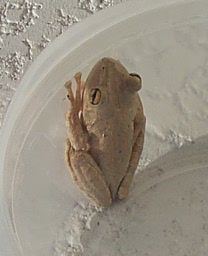|
| 질의: Green lizard | 결과: 66번째/148 | |
Cuban Tree Frog (Osteopilus septentrionalis) - Wiki
| 제목: | Cuban Tree Frog (Osteopilus septentrionalis) - Wiki
| |

| 해상도: 208x256
파일크기: 14546 Bytes
등록시간: 2007:10:08 17:27:30
|
Cuban tree frog
From Wikipedia, the free encyclopedia
[Photo] Cuban Tree Frog (Osteopilus septentrionalis). Photo by Brian Kendig (http://en.wikipedia.org/wiki/User:Brian_Kendig) Copyright (C) 2005 Brian Kendig
Permission is granted to copy, distribute and/or modify this document under the terms of the GNU Free Documentation License, Version 1.2 or any later version published by the Free Software Foundation; with no Invariant Sections, no Front-Cover Texts, and no Back-Cover Texts. A copy of the license is included in the section entitled "GNU Free Documentation License". |
The Cuban Tree Frog (Osteopilus septentrionalis) is the largest species of tree frog in North America, native to Cuba and neighboring Caribbean islands. It has become increasingly numerous in central to southern Florida, where it was accidentally introduced and is considered an invasive species.
Description
The Cuban tree frog ranges in 1.5 to 5.5 inches in length and is anywhere from a gray, light brown, to pale green in color. They also have the ability to switch between these color variations depending on their environment but they usually retain a mottled pattern (slightly spotted) with some banding on their legs. Some also have yellow coloring tucked around their leg areas. Males are smaller than females, and have darker throats and nuptial pads in the breeding seasons.
Diet
The Cuban tree frog is infamous for its huge appetite. Their diet includes almost anything they can overpower, which fits into their mouth, including: insects, other frogs (even frogs of their own species), snakes, lizards, and young birds.
Conservation concerns
The Cuban tree frog is considered to be an invasive species in the continental United States, consuming native frogs and lizards and posing a threat to the biodiversity of the areas into which it spreads. It has spread as far as southern Georgia as of 2004. It hitchhikes on vehicles or relocated soil and plants. The native green and squirrel tree frogs are rapidly disappearing due to its presence. They are also believed to cause power outages by sitting on transformers on electrical poles.
In captivity
Cuban tree frogs are commonly available in the pet trade. They are inexpensive, and when cared for properly tend to live 5-10 years. They feed readily on commercially available crickets.
http://en.wikipedia.org/wiki/Cuban_tree_frog
| The text in this page is based on the copyrighted Wikipedia article shown in above URL. It is used under the GNU Free Documentation License. You may redistribute it, verbatim or modified, providing that you comply with the terms of the GFDL. |
|
^o^
동물그림창고 똑똑전화 누리집
^o^
|
|